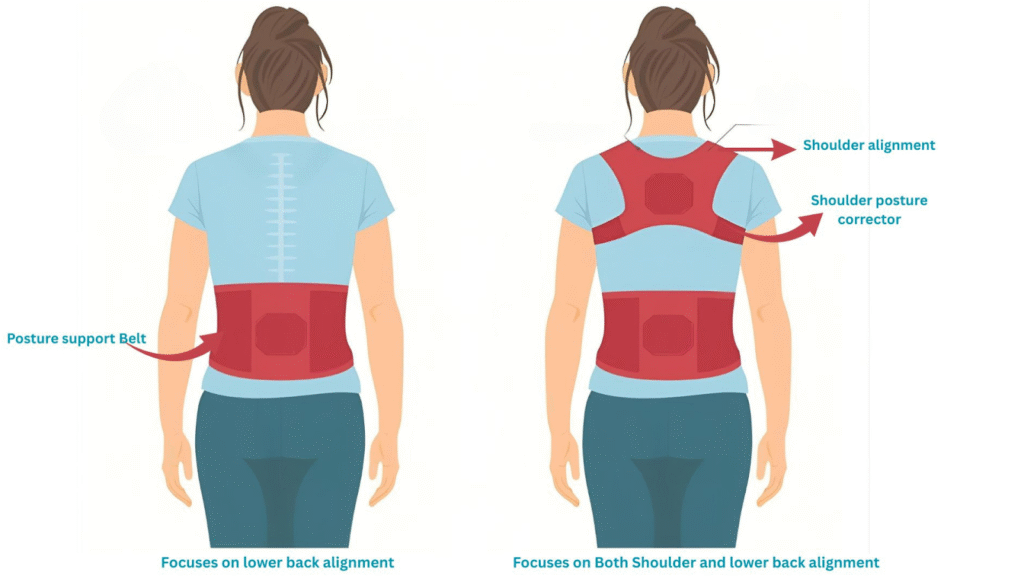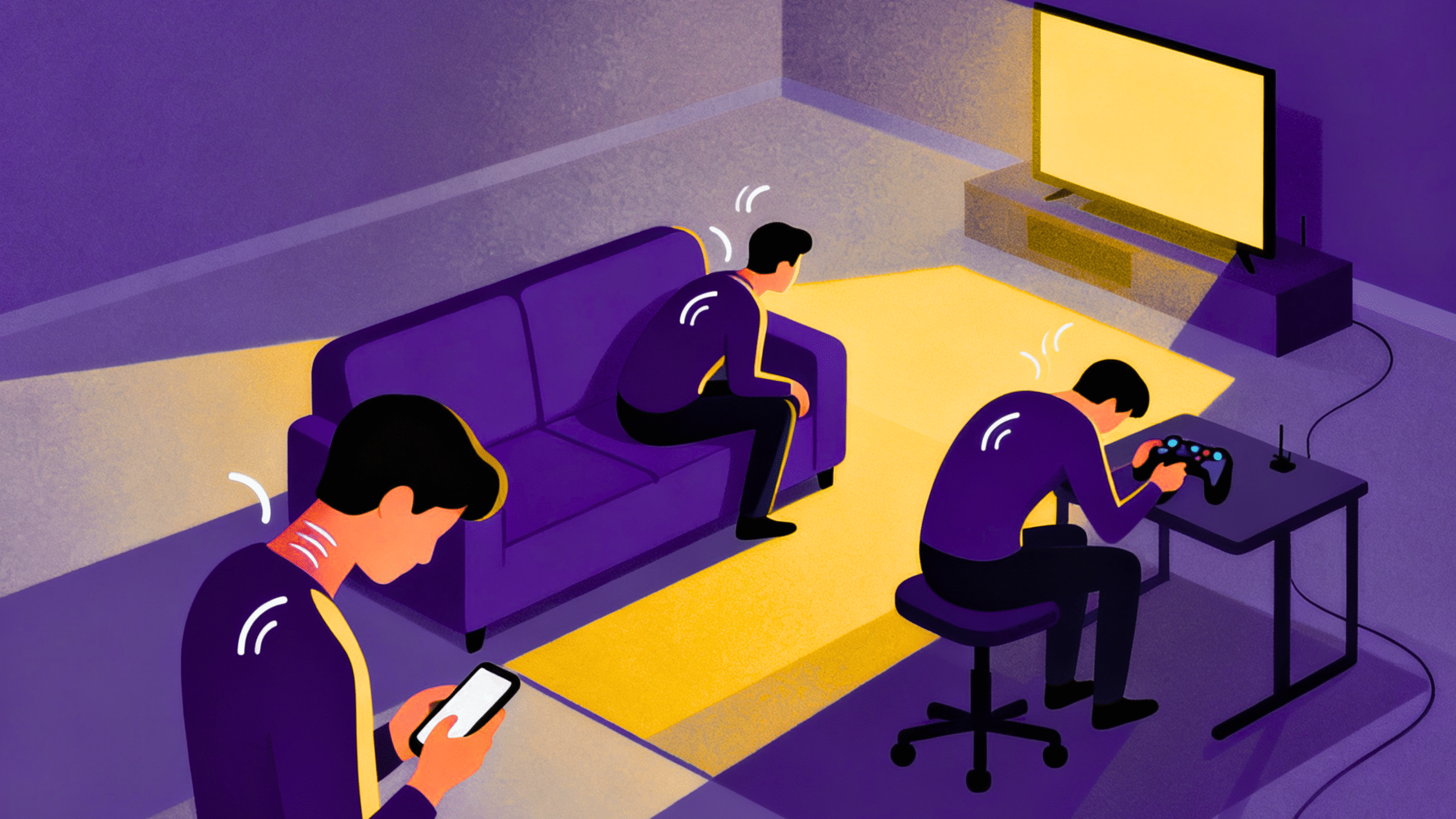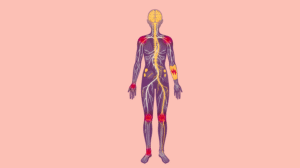We live in a world where people are practically glued to the screens most of the time. Whether it’s endless scrolling on social media , replying to work e-mails , studying online, playing videogames or binge-watching favourite netflix shows, screens have become part of our everyday life. While this digital lifestyle keeps us connected, it’s quietly taking a toll on our bodies, especially our necks and backs.
The term “Tech neck” is no longer just a buzz ; it’s a real problem affecting posture, causing stiffness, pain, and even fatigue. Poor posture, tilted head, and forward-leaning shoulders caused by screens are more than just annoyances [1].Over time, they create long-term postural deformities, chronic pain, and even health issues that silently rob our energy and confidence.
Here’s where the subtle heroes come into play. Simple tools like posture corrector belt, an ergonomic workstation, or even a few easy daily habits can completely change the game.The best part? You don’t have to completely give up on your screens. These little helpers support your spine and muscles, letting you stay comfortable, pain-free, hold your body align and even thrive in our screen-filled world.
In this article, we’ll explore what tech-neck really does to our bodies, the science behind good posture, and how small, practical solutions can help a generation stay youthful and healthy.
What Exactly Is “Tech Neck” and Why Should You Care?
The Rise of Posture Problems from Phone Use
“Tech neck” is a term which refers to the repetitive strain caused by constantly bending your head forward while using devices. Let’s think of it in this way ; When you continously scroll on your phone, your body tends to slouch a bit and with every inch your head moves forward,it increases the weight on your spine. At a 45-degree angle (the classic phone scroll posture), that’s about 50–60 pounds of force pressing on your cervical spine.[2]
Why Netflix Binges and Gaming Marathons Hurt Your Neck More Than You Realize?
Streaming shows for hours or holding a gaming controller may feel harmless. But in reality, these habits lock your muscles in unhealthy positions. The shoulders roll forward, the spine curves unnaturally, and pressure builds in the neck and lower back. It is not the binge that hurts. It is the stillness in one bad posture for hours.
Postural Deformities: When Slouching Becomes Permanent
What starts as occasional stiffness can eventually reshape your spine. Rounded shoulders, hunched backs, and even early degenerative disc issues are not rare anymore, even among teenagers [3].This is why posture devices for gamers and remote workers are gaining attention.
It’s not just about looking good or standing tall, it’s really about protecting your body for long-term musculoskeletal health. Good posture habits and supports like a posture corrector belt play a big role in keeping your muscles, joints, and spine healthy as you age.
How Does Bad Posture Steal Your Energy and Confidence?
The Science of Slouching: Compressed Lungs, Lower Oxygen, Less Energy
When you slump, your chest cavity compresses, making it harder for your lungs to expand. Less oxygen reaches your bloodstream, which means your body literally runs on less fuel. That explains why sitting slouched for hours leaves you feeling drained.[4]
Standing Tall = Instant Confidence Boost
Body language studies have proven that upright posture increases self-esteem and changes how others perceive you. Slouching makes you look tired or insecure. Standing tall signals confidence and competence. A posture support belt helps retrain your body to stay upright, sending the right message both physically and psychologically.[5]
Real-Life Voices: Remote Workers & Gamers Struggling with Tech-Neck
Take Arjun, a 26-year-old software developer who began experiencing headaches from looking down at his laptop or Priya, a college student who thought her back pain was “normal” until she could not sit through her lectures. Both found that some simple fixes in the lifestyle like adjusting screen height, stretching, and occasionally using a posture corrector belt have made a remarkable difference.
Are We All Just One Scroll Away from Postural Deformities?
Digital Lifestyle Posture Risks Nobody Warns You About
Doctors are reporting an increase in young adults with spinal issues previously seen in older patients. Long screen time health issues go beyond discomfort. They include premature spinal wear, reduced flexibility, and even nerve compression.[6]
Long Screen Time Health Issues: Fatigue, Stiffness, Early Degeneration
Poor posture creates a cycle. You feel tired because of restricted breathing, which leads to less activity, which weakens muscles further. Over time, your spine loses its natural curve, and stiffness becomes permanent.
Correcting Postural Deformities Naturally vs. Using Supportive Tools
Yoga, strength training, and mindful awareness are excellent long-term strategies. But when habits are deeply ingrained, tools like an adjustable posture belt or a shoulder posture corrector serve as gentle reminders. They do not actually replace muscle strength, but they guide your body back to alignment.
Can a Posture Corrector Belt Really Help with Tech-Neck?
How a Posture Corrector Belt Retrains Your Spine?
A posture corrector belt works like a friendly coach sitting on your shoulders. It does not force your body into a certain position. Instead, it gently nudges your muscles and spine toward better alignment whenever you start to slouch.
Why Does an Adjustable Posture Belt Work Better Than Quick Hacks?
Many people try balancing books on their heads or forcing themselves to sit upright for hours. These tricks rarely last. An adjustable posture belt adapts to your body and lifestyle, whether you are working, driving, or gaming. The key is consistency, not intensity.
Back Posture Corrector vs. Lifestyle Fixes: Working Together, Not Alone
Think of a posture corrector as training wheels. It helps you relearn how to sit and stand correctly. Combine it with exercises, ergonomic setups, and lifestyle changes for the best results.
Why Gen Z and Millennials Need More Than Just a Gym to Stay Healthy and Pain-Free?
Why Exercise Alone Won’t Undo Years of Slouching?
While strength training helps, many of us assume that a few hours at the gym can fix our posture. Unfortunately, the other 10 hours of bad sitting cancel out the benefits.
Posture Exercises for Neck Pain: Simple Daily Fixes
- Chin tucks: to counter forward head posture.[7]
- Shoulder blade squeezes: to open up rounded shoulders.[8]
- Wall angels: to improve upper back mobility.[9]
Ergonomic Posture Support: Chairs, Desks, Cushions That Matter
Even the best workouts cannot help if your workspace is poorly designed. Ergonomic chairs, laptop stands, and lumbar cushions complement the use of a posture support belt, ensuring alignment is maintained all day.
How to Fix Bad Posture Without Losing Your Mind (or WiFi)
Remedies for Hunched Shoulders at Home or Office
Place your screen at eye level. Keep feet flat on the ground. Roll your shoulders back every 30 minutes.
Sitting Posture Correction Tips for Work-from-Home Warriors
Follow the 90-90-90 rule: knees, hips, and elbows all bent at right angles.
Posture Devices for Gamers and Remote Workers: Which Ones Actually Work?
Among all the posture devices, the shoulder posture corrector is popular for upper-body alignment, while the posture corrector belt offers holistic spine support. The best results come from combining them with conscious breaks and stretches.
Posture Support Belt vs. Shoulder Posture Corrector: What’s the Difference?

Posture Support Belt: Stabilizing Your Spine
This belt primarily supports the mid-to-lower back, preventing slouching when sitting for long periods.
Shoulder Posture Corrector: When Upper-Body Help Matters Most
This device targets rounded shoulders and forward head posture, common in phone users and laptop workers.[10]
Combining Posture Devices + Daily Awareness for Best Results
Each device addresses a different part of the posture problem. Used together with awareness and exercise, they form a complete posture improvement system.
Lifestyle Tweaks: Daily Habits for Better Spine Health
Daily Habits for Better Spine Health You Can Start Today
- Take walking breaks every hour.
- Stretch for 5 minutes before bed.
- Sleep on a supportive pillow that maintains neck alignment.
The 20-20-20 Rule: Screen Breaks for Eyes & Neck
Every 20 minutes, look at something 20 feet away for 20 seconds. It eases eye strain and encourages neck movement.
Ergonomic Hacks: Laptop Stands, Chair Height, Cushions
Small tweaks like raising your laptop with books or using a lumbar cushion can reduce pressure on your spine more than you realize.
The Future of Digital Wellness: Will We All Need Ergonomic Posture Support Devices?
Normalizing Posture Gadgets as Digital Lifestyle Essentials
Just like wearing headphones or fitness trackers became normal, posture devices are following the same path.
AI Reminders & Smart Posture Trackers on the Rise
These days, even your gadgets want you to sit up straight. Many apps and wearables gently buzz the moment you start to slouch, like a little nudge from a friend. Some go a step further and turn posture correction into a game, rewarding you for staying upright and making good posture feel less like a chore and more like a fun daily challenge.
Could the Posture Corrector Belt Become the Next Fitness Tracker?
As awareness grows, the posture corrector belt might soon be as common as water bottles in backpacks. It is no longer just for medical patients but for anyone living a digital lifestyle.
Final Thoughts: Standing Taller in the Tech-Neck Era
Screens are here to stay. Remote work, online learning, gaming, and social media are not going away. But that does not mean your health should be sacrificed.
Bad posture is stealing energy, confidence, and long-term wellness from the Tech-Neck Generation. The solution lies in small, consistent steps. From exercises and ergonomic habits to tools like the posture corrector belt, you can train your body to fight back against slouching.
The goal is not perfection. It is awareness. And sometimes, all you need is a gentle reminder from your shoulders that you are meant to stand tall.
Explore More Health & Wellness Solutions
Want to stay informed about wellness and everyday health issues? Here are some insightful reads to guide you. Explore the links below for practical tips and solutions:-
- https://betterhood.in/learn/5-minute-stretching-routine-for-desk-workers/
- https://betterhood.in/learn/how-pelvic-alignment-affects-lumbar-spine-health
- https://betterhood.in/learn/tech-neck-relief/
- https://betterhood.in/learn/building-stronger-bones-and-joints-after-30-the-role-of-protein-and-calcium/
- https://betterhood.in/learn/workplace-stretches-to-prevent-chronic-pain/
Frequently Asked Questions:
1. What is tech-neck, and why is it harmful?
Tech-neck refers to the strain on the neck and spine from looking down at screens for long periods. It can cause pain, stiffness, and long-term postural deformities.
2. Can a posture corrector belt really fix bad posture permanently?
A posture corrector belt does not permanently fix posture alone. It works best as a supportive tool alongside exercises, ergonomic habits, and awareness.
3. What’s the difference between a posture support belt and a shoulder posture corrector?
A posture support belt mainly stabilizes the spine and lower back, while a shoulder posture corrector targets rounded shoulders and forward head posture.
4: How long should I wear a posture corrector belt daily?
Most experts recommend wearing it for 30 minutes to 2 hours a day to avoid overdependence. It should train your muscles, not replace them.
5. Are there natural remedies for hunched shoulders besides posture devices?
Yes. Exercises like shoulder blade squeezes, yoga poses, and mindful sitting habits are highly effective for correcting hunched shoulders.
6. What daily habits help prevent postural deformities in the digital age?
Frequent breaks, stretching, ergonomic desk setups, the 20-20-20 rule, and using supportive devices like a posture corrector belt when needed.
References:
1. Kim, S. Y., Kim, J. H., Hur, P., & Kim, H. J. (2016). The effect of duration of smartphone use on neck and shoulder muscle fatigue and pain in adults with forward head posture. Journal of Physical Therapy Science, 28(12), 3328-3331. https://doi.org/10.1589/jpts.28.3328 PMC
2. Hansraj, K. K. (2014). Assessment of stresses in the cervical spine caused by posture and position of the head. Surgical Technology International, 25, 277-279. Pubmed.ncbi.nlm.
3. Lotfian, S., Jafari Fesharaki, M., Shahabbaspour, Z., Akbarzadeh, H., & Moezy, A. (2025). The impact of forward head posture on neck muscle endurance and thickness in women with chronic neck pain: A cross-sectional study. BMC Musculoskeletal Disorders, 26, Article 468. https://doi.org/10.1186/s12891-025-08705-https://bmcmusculoskeletdisord.biomedcentral.com/articles/10.1186/s12891-025-08705-w?utm_source=chatgpt.com
4. Lin, F., Parthasarathy, S., Taylor, S. J., Pucci, D., Hendrix, R. W., & Makhsous, M. (2006). Effect of different sitting postures on lung capacity, expiratory flow, and lumbar lordosis. Archives of Physical Medicine and Rehabilitation, 87(4), 504–509. https://doi.org/10.1016/j.apmr.2005.11.031
5. Nishijima et al. (2015) showed that a lumbar support belt helped reduce forward bending postures in working tasks and lowered subjective discomfort. J-STAGE
6. Korkmaz, M., Kaya, O., Celik, Y., Türkeri, K., & Sokmen, N. (2021). Correlation of cervical spinal degeneration with rise in smartphone usage time in young adults. Journal of Back and Musculoskeletal Rehabilitation, 34(6), 927-934. https://doi.org/10.3233/BMR-201228 PubMed
7. Nishanth, H. (2021). Immediate effect of chin tuck exercises on craniovertebral angle and shoulder angle among collegiates with forward head posture. Biomedical & Pharmacology Journal, 14(4). https://doi.org/10.13005/bpj/2319Biomed Pharma J
8. Nam, C. W. (2017). Changes in rounded shoulder posture and forward head posture when employing the self-stretch exercise, the self-stretch with strengthening, etc. Journal name (exact journal details as per source) PMC
9. Lu, M., PT, DPT (2024). How to Do Wall Angels: Tips and Stretch Variations. Hinge Health. hingehealth
10. Hamzelouie, R., Khaghani, A., & Azadinia, F. (2021). Immediate effect of forward head rounded shoulder posture corrective orthosis on craniovertebral and protraction-retraction angles. Koomesh, 23(23), 365-371.https://brieflands.com/articles/koomesh-149955?utm_source=chatgpt.com



















